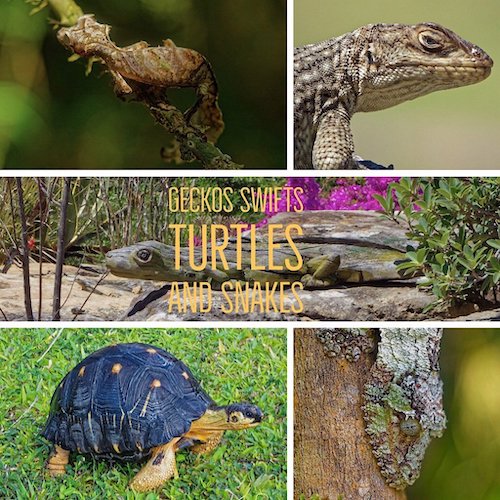Madagascar is home to an abundance of beautiful and unusual animals many of whom are unique to Madagascar because of its relative isolation. This is not just any isolation, Madagascar was once a part of the supercontinent Pangea but between 160–117 million years ago, it began separating, rifting southward over 1000 km away from the Africa plate. The Middle Jurassic is one of the key periods in the evolution of life on earth. Many groups, including dinosaurs and mammals, diversified during this time. The Opluridae, or Madagascan iguanas, are a family of moderately sized lizards native to Madagascar and Grande Comore islands. There are eight species in two genera, with most of the species being in Oplurus. The family includes species that live amongst rocks, some that live in trees, and two that prefer sandy habitats. All of the species lay eggs, and have teeth that resemble those of the true iguanas. A study of mitochondrial DNA sequences has dated the split between Opluridae and the New World Iguanidae (within which Opluridae are sometimes classified as the subfamily Oplurinae) at about 165 million years ago, during the Middle Jurassic.
Great Rift Valley
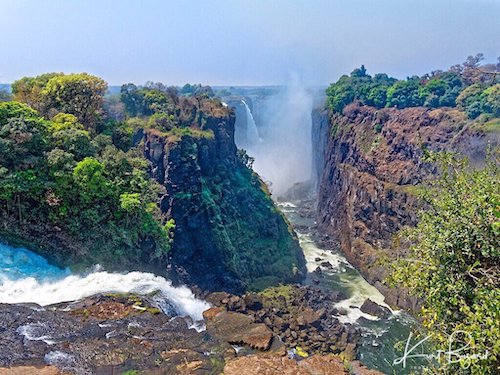
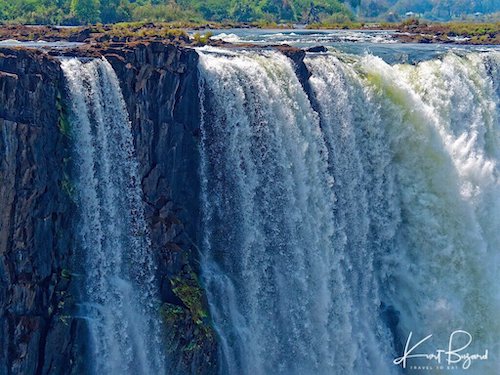
The Great Rift Valley is like a jagged scar on the face of Africa. It extends from South Africa, along the eastern region, and up to the Arabian Peninsula. The Great Rift Valley is a long line of escarpments that have been created by two tectonic plates drifting apart. Valley walls can rise anywhere from 2,000 to 9,000 feet high. The Great Rift Valley also helped to create other major landforms such as Lake Victoria, Lake Tangynika, and Victoria Falls which is a part of the Zambezi River. The Great Rift Valley is being formed by the movement of tectonic plates, the same process that created the Himalayan Mountains in Asia and moved Madagascar away from Africa. But, put this process in reverse. Rather than plate collision, it is plate separation that is creating the rift. Africa is literally being pulled apart as the Africa plate is breaking into two separate plates, a very rare occurrence. In the next 10 million years or so, East Africa will have broken away from the continent forming its own subcontinent.
Allopatric Speciation
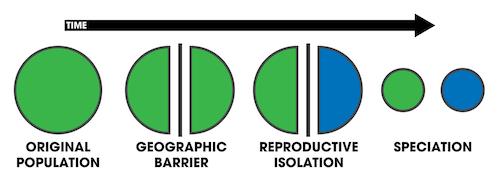
In 1859, after visiting the Galápagos islands, Charles Darwin set out his theory of evolution by natural selection as an explanation for adaptation and speciation. He defined natural selection as the “principle by which each slight variation of a trait, if useful, is preserved. Allopatric creation of new species is caused when a population is separated by a physical barrier. It is also referred to as geographic speciation. Speciation is the scientific name for the creation of new species. Sympatric speciation is speciation that occurs without physical separation of members of the population. Reproductive isolation acts as the primary mechanism driving genetic divergence in allopatry and can be amplified by natural selection.
Pangea the Supercontinent
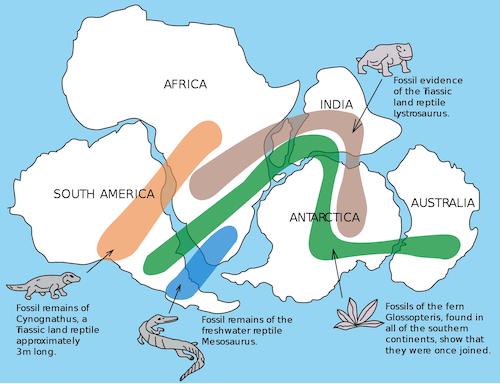
The forming of supercontinents and their breaking up appears to have been cyclical through Earth’s history. There may have been many others before Pangaea. Because of its long separation from neighboring continents, through tectonic movement, Madagascar split from Africa about 160 million years ago, and from India around 90 million years ago, it contains many species endemic to the island. DNA-based evidence finds that birds diversified dramatically around the time of the Cretaceous–Palaeogene extinction event 66 million years ago, which killed off the pterosaurs and all the non-avian dinosaur lineages. But birds, especially those in the southern continents, survived this event and then migrated to other parts of the world while diversifying during periods of global cooling. This makes them the sole surviving dinosaurs according to cladistics. Of the 287 bird species recorded on Madagascar, 105 are found nowhere else on earth, and a handful of others are shared only with the neighbouring Comoro Islands. Although birds are thought to be the only living dinosaur descendants, some other animals living today are related to the dinosaurs. Dinosaurs are in the reptile group, which includes turtles, crocodiles, birds, lizards, and snakes. Of these groups of animals, second to birds, crocodiles are probably the closest related to dinosaurs (though they are not considered modern dinosaurs themselves, unlike birds).
Squamata or Scaled Reptiles
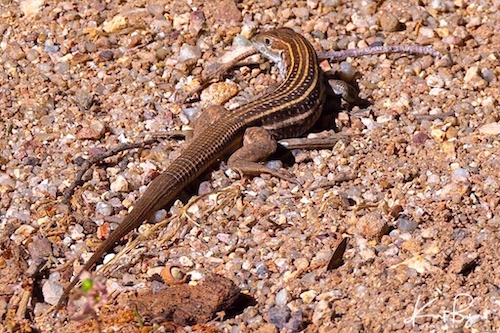
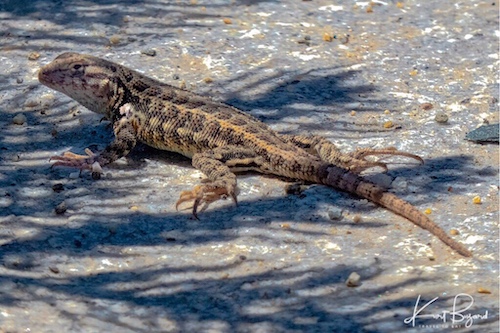
The Squamata, or the scaled reptiles, are the largest recent order of reptiles, comprising all lizards and snakes. With over 10,000 species, it is also the second-largest order of existing vertebrates, after the perciform fish, and roughly equal in number to the Saurischia (one of the two major groups of dinosaurs). Members of the order are distinguished by their skins, which have horny scales or shields. From their appearance, the iguanas were long thought to be the most ancient branch of the tree however, studies of the DNA suggest that the geckos represent the most ancient branch. Iguanas are now united with snakes and anguimorphs in a group called Toxicofera. DNA also suggests that the various limbless groups, like snakes, are unrelated, and instead arose independently from lizards.
Mossy Leaf-Tailed Gecko
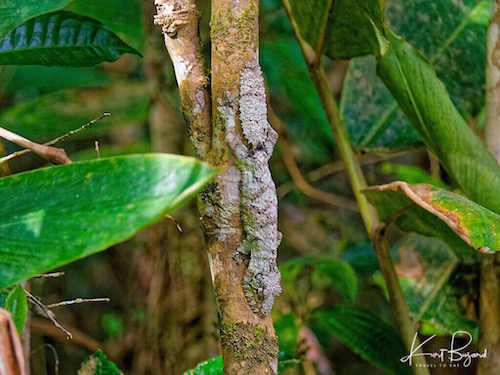
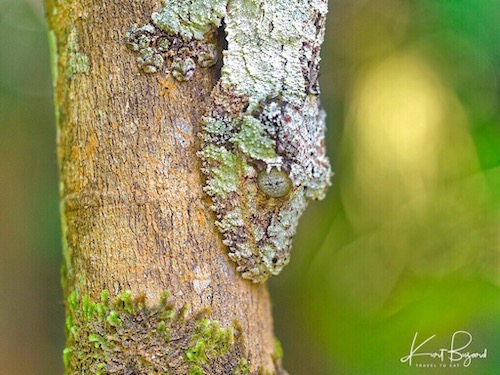
There are few animals in the world that exhibit such incredible camouflage as the group of geckos in the genus Uroplatus. Their generic name, Uroplatus, is a Latinization of two Greek words: “ourá” (οὐρά) meaning “tail” and “platys” (πλατύς) meaning “flat”. Its common name refers to the mossy-like camouflage patterns and colors of the lizard’s skin. Mossy leaf-tailed geckos (Uroplatus sikorae) are nocturnal and arboreal (live in trees). Their eyes are large and lidless, and have yellow sclera with slit-like pupils, suited for the gecko’s nocturnal habits. These geckos rely on their natural camouflage as they dwell among the trees. They spend most of the daylight hours hanging vertically on tree trunks, head down, resting. During the night, they will venture from their daylight resting spots, and go off in search of prey. It has the ability to change its skin color to match its surroundings and possesses dermal flaps which break up its outline when at rest. Mossy leaf-tailed geckos are eat insects, arthropods, and gastropods. The mossy leaf-tailed gecko ranges in size from 15 to 20 centimetres (6 to 8 in) when measured from nose to base of the tail.
Satanic Leaf Tailed Gecko
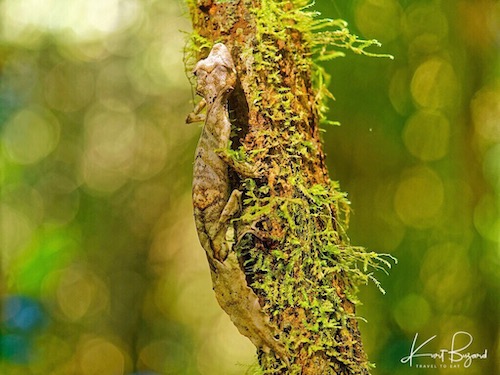
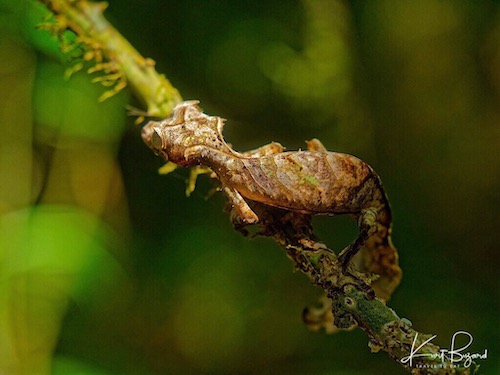
Satanic Leaf Tailed Geckos are some of Madagascar’s most unusual and magnificent creatures. They have the ability to make themselves almost invisible by becoming indistinguishable from fallen leaves or blend in to the tree’s bark. They are considered a vulnerable species primarily caused by habitat loss due to deforestation across their native island of Madagascar. Since they are very popular as pets, illegal trade is another big concern for the existence of this reptile. The adult size is 2.6 to 6 inches (66 to 152 mm) in total length, including the tail. As with all Uroplatus geckos the tail is flattened, some even have notches in their tails to further mimic a decaying leaf. This is also thought to be a form of sexual dimorphism, as the trait seems more common in the males of the species. In addition, the Satanic Leaf Tailed Gekko has an eyelash-like projection above each eye, like the horns of the devil (hence the name). During daylight hours, these adaptations help the gecko blend into its surroundings. At night it helps the gecko hunt for prey by providing camouflage. Geckos possess no eyelids, just a transparent covering over their eyes, and so they use their long, mobile tongues to wipe away any dust or debris that gets into the eye. The gecko occurs in a variety of colors, including hues of purple, orange, tan and yellow, but is often mottled brown, with small black dots on the underside that help to distinguish it from similar species.
Lined Day Gecko
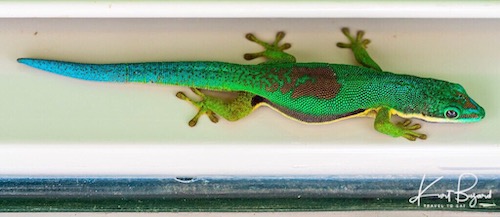
Day geckos of the genus Phelsuma are different from other geckos for several reasons. Unlike most other geckos, day geckos are diurnal (active during the day) hence their name. They are also very territorial and they are very colorful. Phelsuma lineata, the lined day gecko, is a species of diurnal gecko native to Madagascar and not incidentally are highly sought after as beautiful pets. The lined day gecko has soft, green skin on its back, a brick red spot in the middle of the back and a distinct black band running down the side of its body, bordered on the lower edge by a light-colored stripe. It commonly measures between 10 and 14.5 cm in length. This species is found on banana palms, trees, buildings and Pandanus screw palms, in fact I found this one in a gutter drain. There are three subspecies, although the species is not well categorized. One subspecies occurs in humid forest in Pandanus trees, another inhabits bushes and buildings in drier areas while the third glues its eggs to a substrate (the remaining subspecies do not).
Peacock Day Gecko
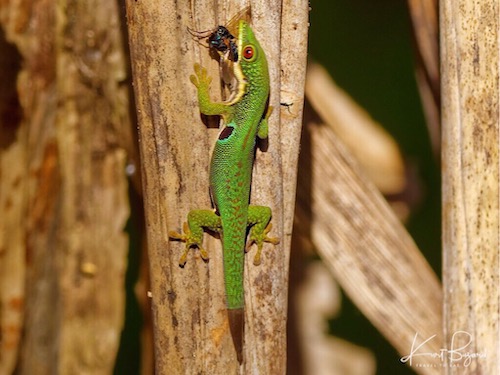
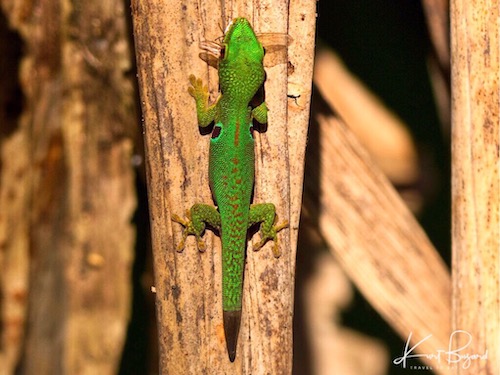
These are smaller sized geckos from the genus Phelsuma, and can come from the islands surrounding Madagascar, although I found this one in Ranomafana National Park. They are primarily a rich, emerald green color, with red markings along their back and heads. Their common name derives from the black spots found behind their front legs and in front of their rear legs. These spots are often outlined in blue but less commonly red or white. Peacock Day Geckos are rainforest dwelling geckos, and are found in areas with large amounts of annual rainfall. There are distinct seasons within their range, and while summer temperatures can reach 90 degrees during the day, winter temperatures drop as low as 50 degrees at night. They eat insects, this one was in the middle of devouring a fly, but will also eat fruit and flower nectar.
Cuvier’s Madagascar Swift or Iguana
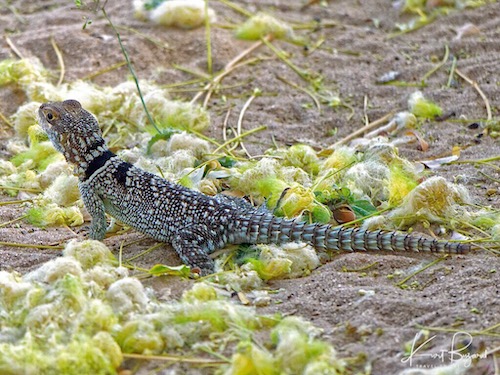
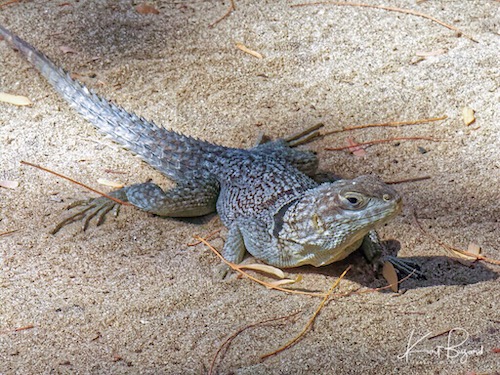
As I mentioned in the beginning of this post, the swifts on Madagascar look like New World Iguanas but in fact predate them. Oplurus cuvieri, commonly known as the collared iguanid lizard, collared iguana, Madagascan collared iguana, or Cuvier’s Madagascar swift, is a species of arboreal Malagasy iguana, the largest of six species in the genus Oplurus. This species is mostly arboreal. In dry forests it occurs on trees but is also active on the ground, whilst in more humid regions of the north it inhabits riparian forest and plantations. Cuvier’s Madagascar Swift is an ambush predator that waits for prey whilst remaining motionless on the tree trunks or branches. Insect prey is captured with a swift lunge from the ambush point. It occasionally eats flowers on the ground. Eggs are heavily predated by snakes. Open areas of habitat inside or alongside deciduous forest are important in the rainy season because they provide access to direct sunlight which Oplurus cuvieri needs for thermoregulation. The number of dorsal black bands on Oplurus cuvieri is affected by thermal conditions, they appear to be important in thermoregulation and lizards captured in forested areas had more bands than those from the open. I saw this swift in the North of Madagascar at the Anjajavy Lodge.
Duméril’s Madagascar Swift or Iguana
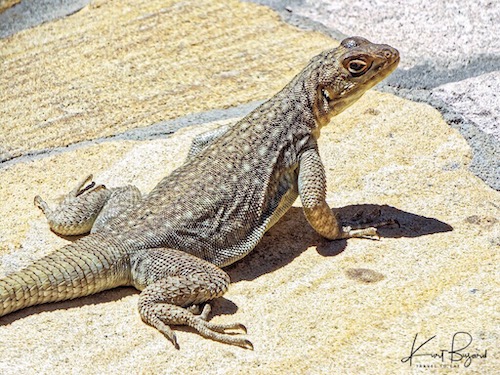
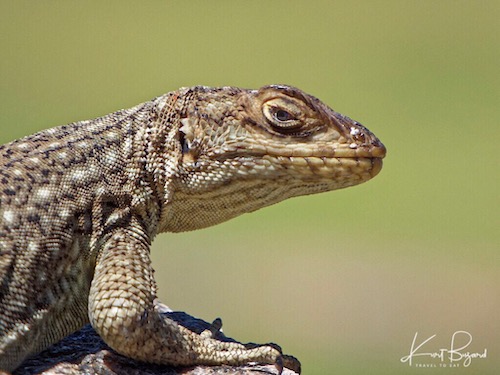
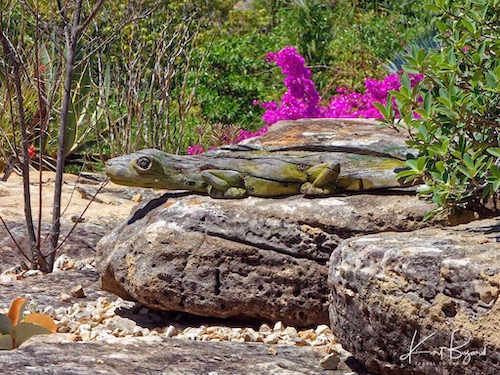
Oplurus quadrimaculatus, the Duméril’s Madagascar Swift or Madagascar spotted spiny-tailed iguana, can reach a length of 9.8–15.4 in (25–39 cm). This iguana is greyish, with a spotted back and tail and legs covered with enlarged, spinous scales. It spends hours basking in sunlight. It is mainly insectivorous. Mating lasts just a few seconds and the eggs are laid in sheltered areas. This species is endemic to Madagascar. It can be found from the central areas up to the south of the country, at an elevation up to 6,730 ft (2,050 m) above sea level. Duméril’s Madagascar Iguana lives on loamy slopes, clay expanses and large rocks in various environment, from the arid regions in dry spiny forests to northern wetlands and humid areas close to the rainforest and in shrubland. I saw these in the dry southern part of Madagascar at the Relais de la Reine Lodge where they were so numerous that they had a large carved figure of the lizard.
Green Bright-Eyed Frog
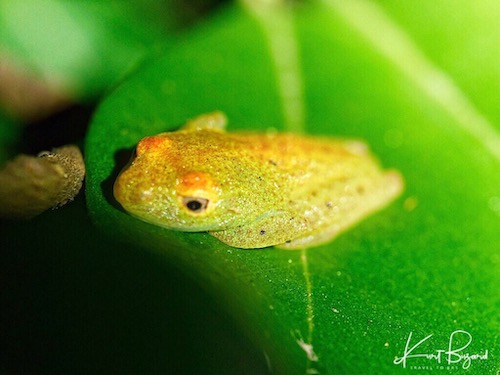
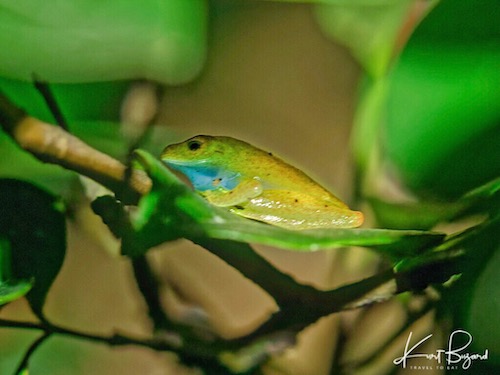
Mantella (also known as golden frogs or Malagasy poison frogs) are a prominent genus of poisonous frogs in the family Mantellidae, endemic to the island of Madagascar. One of the largest genera within the Mantellidae family is Boophis, the “bright-eyed frogs”. These are classic tree frogs with enlarged tips to their toes, large eyes, and nocturnal habits. Most live on the ground but may sleep in small bushes, exhibiting bright coloration or cryptic markings which are species specific. All the species of the genus are considered small frogs, typically varying in sizes of 0.71–1.22 in (18–31 mm). A common characteristic across most species within the genus is that species are sexually dimorphic in size, with female specimens usually being larger than males. Mantella are often compared to the unrelated South American poison dart frogs of Dendrobatidae due to their use of aposematism (from Greek ἀπό apo away, σῆμα sema sign), a defense mechanism that uses dramatic colorations to deter potential predators. Colorations and markings vary from species to species, with combinations of green, red, orange, yellow, blue, brown, white and black. These colorations are often evidence that the specimen is, to a degree, toxic with poisonous active alkaloid secretions.
Radiated Tortoise
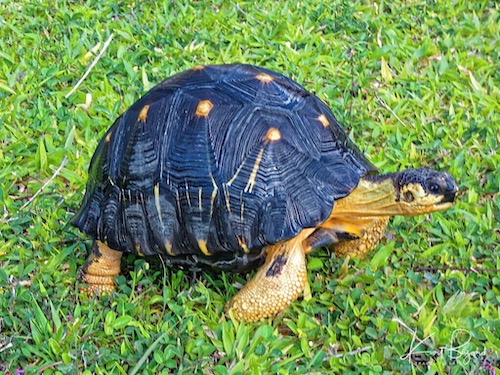
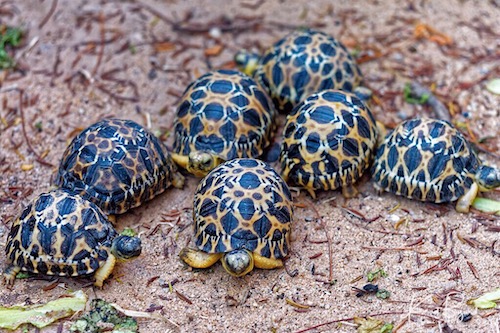
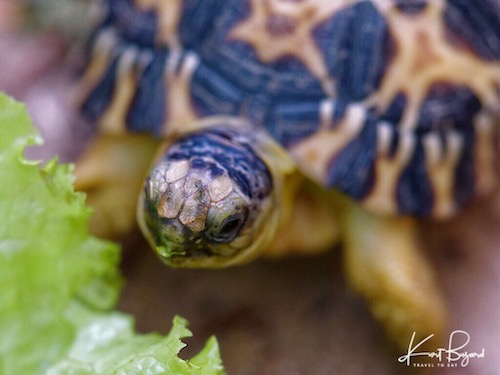
The Radiated Tortoise (Astrochelys radiata) is a species in the family Testudinidae. Although this species is native to and most abundant in southern Madagascar, it can also be found in the rest of this island, and has been introduced to the islands of Réunion and Mauritius. It is a very long-lived species, with recorded lifespans of at least 188 years. These tortoises are classified as critically endangered by the IUCN, mainly because of the destruction of their habitat and because of poaching. Radiated Tortoises are found in the dry spiny forests of southern and southwestern Madagascar, from the area of Amboasary in the south across the Karimbola and Mahafaly plateaus north of Tuléar (where the habitat is highly fragmented and tortoises may be close to extinction) to Morombe. They are usually found in a narrow band within about 50 to 100 km from the coast. Because these animals are critically endangered, the Relais de la Reine Lodge in southern Madagascar has a program to raise them on the grounds.
Madagascar Tree Boa
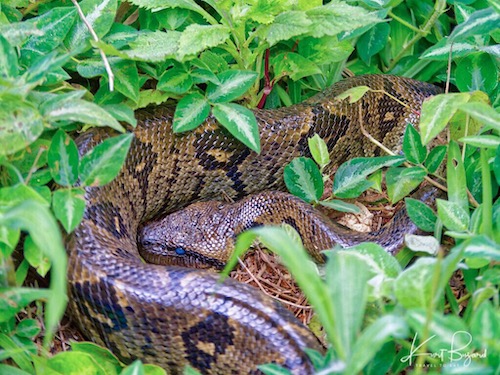
Sanzinia madagascariensis (also known as the Malagasy tree boa, or Madagascar tree boa) is a non-venomous boa species endemic to the island of Madagascar. Two subspecies are currently recognized: Sanzinia madagascariensis madagascariensis is greenish in color and is found on the east side of Madagascar and Sanzinia madagascariensis volontany is brownish in color and is found on the western side of the island. The triangular head features deep grooves on the upper lip, which probably contain thermal receptors used in nocturnal hunting. It is generally nocturnal and feeds on mammals and birds. Its thermoreceptive pits help it to locate its prey. It will also leave the trees to actively hunt for small mammals on the ground. As you can see, it has bright blue eyes which give it a particularly sinister appearance.
As always, I hope you enjoyed the post, please leave a comment.


